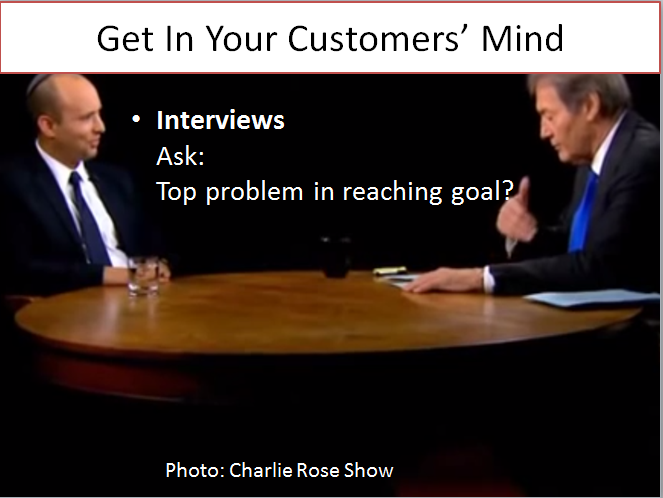Years ago I learned the concept of market research incorrectly and ended up testing all sorts of variations and continually editing my site and pages in response to low conversion rates. I was testing based on guesswork about what customers might want. Learning to do market research right, as we’ll see, can make a huge difference to conversion rate.
My Humble Beginnings With Market Research
When I learned about marketing personas, defined as made-up, named profiles that represent your customer segments, the blogs I read touted their benefits, but barely shared any advice on how to invent these personas. The impression I got was that you used a little data and a lot of imagination.
From seeing other people’s personas, I know that I’m not alone. There are perhaps 9 parts imagination and 1 part actual market research!
The reason why people were so clueless is that market research is a discipline that has been poorly taught, until recently.
In the blogosphere, it’s a barely-covered topic that mostly is limited to keyword tools and maybe demographic data.
Offline, my college business classes taught approaches requiring budgets that small businesses lack. Are you going to run a nationally representative survey to launch a new ecommerce shop? Probably not.
With the advent of lean startup methods – and, in particular, Ash Maurya’s book, Running Lean, and the blog, Customer Development Labs, this problem has been solved, conclusively.
The marketing world still hasn’t caught on to this revolution, though. Most marketers have barely heard of lean, let alone read Running Lean or Customer Development Labs.
This post is meant as an introduction to lean market research and reality-based persona creation.
What Do We Need To Determine From Market Research?
Market research should give us the answers to two questions. These questions are fundamental and not just geared toward product strategy, but to marketing strategy. Indeed, product and marketing are really just two sides of the same coin.
- Why do people want to buy my product or service?
- Who wants to buy?
You probably have a general idea of an answer for both before starting, but you want to get specifics. It’s an iron rule of marketing that specifics beat generalities. (That’s why, for example, most dating sites tell you that there are X users of gender A online in {your city}, rather than “lots of members in your country.”)
Now that we know what we’re trying to find out, let’s see how lean startup methods help us find the answers to our questions.
Problem Interviews – The Genius Innovation Of Lean
Prospect interviews are the core of market research. There are two types of prospect interviews: problem and solution interviews.

Everyone knows that businesses exist to solve problems for their customers. The first step in market research is, therefore, to find out the problems of your potential customers. That’s why the first type of prospect interview is called a problem interview – you’re not selling but just looking to see what the need is.
The main part of the script for your interview goes like this:
- Find out what they want to achieve.
- Find out what problems stand in the way.
- Ask them to rank the problems they shared from most painful to least painful.
“[Small talk then segue…]
- “What’s your main goal with [area of focus]?”
In my case, working on a Jewish dating site, I asked Jewish singles what their primary goal dating goal was.
I did this after a venture capitalist challenged my assumption that most Jewish singles who are dating want to get married, and after I’d already done most of my problem interviews. So in my case this took the form of a survey shared with friends and their friends. I also wanted to do a survey rather than just more interviews because I needed quantitative data – which I could get by looking at the average scores for each goal that singles had – and not just qualitative data.
The point is the same – rely on data, not your opinion. (As it turned out my assumption was correct, but now I could justify my opinion with data.)
With your answer in hand, you go to question 2:
- “What are the 2-3 main problems you’re having with achieving goal X?”
In my case, the goal most people articulated was “to have a serious relationship that can lead to marriage.”

So that yields: “What are your 2-3 biggest challenges with getting into a serious relationship that can lead to marriage.”
And then based on that,
- “Which of the problems discussed were the worst?”
After a few rounds of testing, you’ll probably be able to skip question 1, and eventually also question 2.
While Ash Maurya encourages folks to imagine problems and ask their prospects to rank them, I’ve found that to be a premature jump when you’re starting out. It assumes that you know more than you do, and in my case just resulted in wasted time and opportunity.
Each interview is a chance to learn, so you want to make the most of it by being humble and not assuming that you know things when you’re beginning.
After you’ve found out about people’s problems, you can follow up with some demographic questions as relevant to your niche, to get a better idea of the context of the answers obtained. For best results, you’re better off interviewing people with similar demographics and location so that you can see patterns faster.
How Does This Market Research Translate To Personas And Benefit Your Marketing?
The end product of these interviews is the identification of the most common problems and tying them to the demographic traits of the people who have them.
For example, you might have found out that “divorced moms aged 30+” struggle finding the time to date while they’re also working and raising kids. That’s one persona. Let’s call her Jane.
In practice, the personas allow you to target your ads accurately, segment your visitors, write targeted copy and choose relevant hero pictures.
Without this research, perhaps you might have targeted your time-saving service to an imagined divorced male persona over 40. Your ad targeting would be wrong and both your copy and hero image would cater to the wrong gender.
With the research in hand, you can target ads to Jane accurately using demographic targeting and by running ads on sites that cater to Jane.
Not only that but since your homepage gets visitors from multiple sources and can’t always adapt based on the source, it can at least effectively segment visitors according to their needs – which you’ve discovered from the interviews. This is, in fact, true for keywords that bring you traffic from multiple audience segments, regardless of what page they land on. The homepage is just one common example.
Lastly, with personas your phrasing will exactly match how your customers describe the problem. What better copywriting could you want?
Basing Your Personas In Lean Market Research Will Do Wonders For Your Conversion Rate
Instead of guessing who your customers are and what they need, interview some prospects. Find out what their goals are for your contemplated field of business and what problems prevent them achieving those goals.
In combination with demographic data, you’ll be armed with exactly the right knowledge to tailor your marketing messages neatly to your prospects’ needs and identities. As a result of segmenting and speaking to each segment separately, you can personalize your approach and get a dramatically higher conversion rate.



